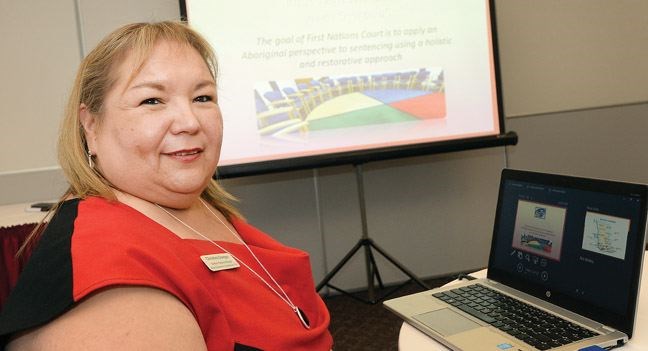When Christina Draegen first started as a native courtworker after almost a decade counselling, the shift in perspectives was profound. She didn't see any movement toward healing in the court system. She saw anger, frustration, confusion and a revolving door of Aboriginal offenders.
"I thought something has to change here," said Draegen, the northern regional manager of the Native Courtworker and Counselling Association of B.C.
"The existing court system is more of a punishment situation and that is just not working for our people."
That change is tied to a justice system that acknowledges generations of trauma and the legacy residential schools have created and contributed to the staggering overrepresentation of Aboriginal offenders in the system.
"We want to switch that around and give a chance for healing instead of the punishment and that's where First Nations courts come in because they facilitate that opportunity," said Draegen, presenting on the last day of the three-day Healing Conference at the Civic Centre.
"The court process is slowed down and we're going to take time to see the root of what's going on for that individual, what's bringing them to that place, getting involved in the criminal justice system and how can we help."
Though she'd hoped to have a First Nations court up and running in Prince George this year, the soonest would be 2017 and is completely contingent on sign-off from the province. Part of the pitch needs to be finding a suitable judge who is open to the process and wants to do it.
"They have to come from a place of heart, not just mind, not just to get the process done, but to actually have care," Draegen said, adding the ultimate goal is to bring more of the sentencing courts to the north.
In Prince George, the court would likely be in the family conference room rather than a traditional set-up with a judge on a bench.
"We're going to sit around a table and we're all going to be equal," she said, involving elders who have undergone training as well as cultural elements.
"To have that kind of ceremony I think would change the whole energy of that court house."
The city is one of six communities that have already asked the province for a First Nations court.
Four already exist in B.C., "but they're all down south" noted Draegen, despite the north having a much higher Aboriginal population. In Prince George, 11 per cent of the population identifies as Aboriginal compared to five per cent for the whole province.
When councillors met with Suzanne Anton, the Minister of Justice at the Union of B.C. Municipalities last month, they advocated for the approach and recently Draegen met the assistant deputy minister Kurt Sandstrom with the same goal in mind.
"It sounds like they have been listening," said Draegen, but it's still not enough. "We need to actually get something concrete."
"What's the hold up here?" added Prince George RCMP Supt. Warren brown at the end of her presentation. Local MLAs, too, have expressed support. "They're listening, I wish one of them would write a cheque and make it happen already."
Aboriginal people represent five per cent of B.C.'s adult population but represented 24 per cent of all provincial inmates in 2013 and 2014. From 2001 to 2011, the federal Aboriginal inmate population increased by 56 per cent and provincially in recent years, the increase has been 30 per cent, Draegen said.
"That's alarming," she said, adding incarceration rates are estimated to be 10 times that of the non-Aboriginal population.
"There has to be a new, a creative, a better way of doing things," said Brown, touching on the need for change to the system and recommendations in the Truth and Reconciliation Commission addressing justice issues.
"It's so obvious it's the nose on your face," Brown said.
Justice Murray Sinclair called on all governments to invest in ways that "provide realistic alternatives to imprisonment for Aboriginal offenders and respond to the underlying causes of offending" as well as recognizing and implementing Aboriginal justice systems.
Part of the problem that's holding up the provincial commitment is that neither the government or the native courtworkers have tracked the existing First Nations courts - in Kamloops, North Vancouver, Duncan and New Westminster - for data to prove success.
"We know that it's working because of what we hear from our native court workers and (offenders) aren't returning to the court environment," said Draegen, and the organization has also started monitoring the results to build up evidence. "For us that's a measurable outcome that something is working in a good way."
The important thing, said Aboriginal liaison officer Jason Gillis, is that organizations are open to new approaches and work toward the same goal.
"That's how great things happen."



